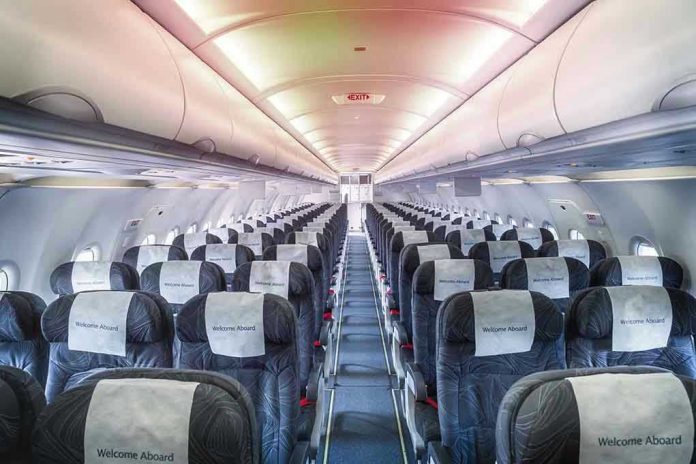
When an unusual odor fills the air, it can ground even the most routine flight, raising questions about safety and the intricacies of cabin environments.
Story Overview
- An American Airlines flight was diverted due to a mysterious odor, leading to five hospitalizations.
- The incident underscores the importance of emergency protocols in aviation.
- An ongoing investigation seeks to identify the odor’s source.
- The event highlights broader concerns about air quality in commercial flights.
Emergency Response and Immediate Actions
An American Airlines flight recently faced an unexpected challenge when a strange odor permeated the cabin. The crew, prioritizing passenger safety, declared an emergency and rerouted the aircraft to the nearest suitable airport. Upon landing, emergency responders swiftly evaluated the situation, leading to the hospitalization of five individuals as a precautionary measure. These actions underscore the airline’s commitment to safety and adherence to emergency protocols, reflecting the industry’s preparedness for such unforeseen events.
5 on board American Airlines flight hospitalized after odor diverts planehttps://t.co/IVPfFE4Swd
— BREAKING NEWZ Alert (@MustReadNewz) November 25, 2025
The quick response not only ensured the well-being of those on board but also initiated an investigation to uncover the root cause of the odor. This incident is not an isolated case in aviation history, as “fume events” can occur due to various technical malfunctions or chemical exposures. While the immediate health impact on the affected individuals is yet to be determined, the precautionary hospitalization highlights the potential seriousness of such events.
Understanding Fume Events in Aviation
Fume events in aircraft cabins, though rare, have been documented in the aviation industry over the years. These occurrences often stem from oil leaks, hydraulic fluid mishaps, or issues with air conditioning systems. The complexity of aircraft systems means that even minor malfunctions can lead to noticeable cabin conditions. Historically, regulatory bodies like the FAA have taken such incidents seriously, issuing guidelines and conducting investigations to mitigate risks and enhance passenger safety.
The incident involving American Airlines is a stark reminder of the need for vigilance in monitoring air quality aboard flights. While most fume events result in minor discomfort, the potential for more severe health implications cannot be ignored, especially if exposure is prolonged or repeated. This case may prompt further scrutiny and possibly lead to updated safety protocols within the industry.
Stakeholders and Their Roles
The key players in this scenario include American Airlines, the passengers and crew, emergency responders, and regulatory authorities such as the FAA. American Airlines, bearing the responsibility of ensuring passenger safety, has been actively cooperating with investigators to determine the cause of the odor. The passengers and crew, directly affected by the event, are seeking clarity and assurance regarding their health and safety.
Regulatory authorities are tasked with overseeing the investigation, ensuring compliance with safety standards, and potentially implementing new regulations based on findings. Meanwhile, emergency responders played a crucial role in providing immediate medical evaluation and transport. The collaborative efforts of these stakeholders are vital in addressing the incident and preventing future occurrences.
Implications for the Aviation Industry
The incident has sparked renewed attention on the importance of cabin air quality in commercial aviation. In the short term, disrupted travel plans and potential health monitoring for those affected are immediate concerns. However, the long-term implications could involve stricter regulatory scrutiny and possible adjustments to maintenance and safety protocols.
The aviation industry may see a heightened focus on developing technologies for detecting and addressing cabin air contaminants. Airlines might also enhance training for crews to manage fume events more effectively. Ultimately, this event serves as a catalyst for ongoing discussions about passenger safety and the environmental conditions within aircraft, potentially influencing policies and practices industry-wide.












